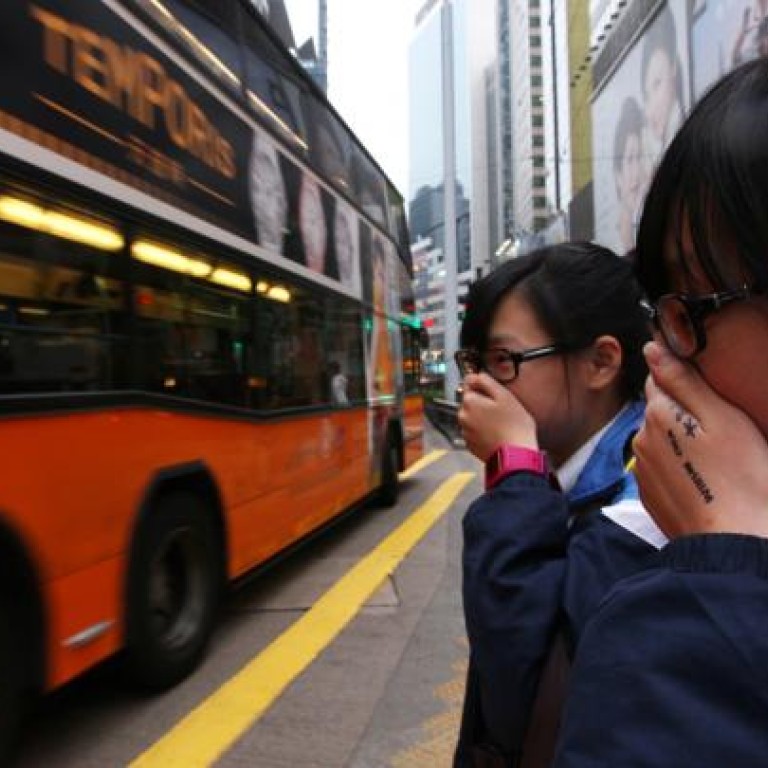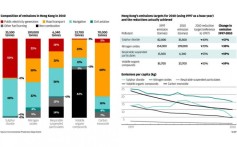
Air pollution in Hong Kong from ships and vehicles gets worse
Power plant action helps Hong Kong hit overall clean-air goals but vehicles and ships creating more pollution than before, officials admit
Roadside air quality and marine-related air pollution have worsened even though the city has achieved its overall clean-air targets under a joint scheme with Guangdong province.
According to the 2010 pollution inventory released by the Environmental Protection Department yesterday, the level of emissions for four pollutants - sulphur dioxide, nitrogen oxide (NOx), respirable suspended particulates and volatile organic compounds - in 2010 were reduced by 30 to 59 per cent, compared to 1997.
Guangdong has yet to release its results.
The decreases met the levels required under a joint scheme with Guangdong to cut emissions, using 1997 as the base year.
The reduction of the major pollutants sulphur dioxide and NOx was attributed mostly to improvements in reducing power plant pollution, which accounted for half of total emissions. Power plants have also been switching to natural gas rather than coal, which has led to cleaner fuel and fewer emissions.
However, the other sources - vehicles and ships - have created more pollution than before. Vessels emitted a total of 35,000 tonnes of NOx in 2010, up by 8.3 per cent on 2009, and they were also responsible for 16,900 tonnes of sulphur dioxide in 2010, a 9.7 per cent increase from the previous year.
Road transport accounted for 286 tonnes of sulphur dioxide in 2010, up from 271 tonnes in 2009. It emitted 32,700 tonnes of NOx in 2010, a mere 1 per cent decrease from 2009.
Andrew Lai Chi-wah, the deputy director of environmental protection, admitted that roadside and ship-related air pollution were worsening. "We understand that people may not feel that they are breathing cleaner air despite the reductions. We acknowledge the problem," he said.
"Indeed, we have done less in cleaning up the ships and vehicles than we did with power plants. We are stepping up measures in these aspects." Lai admitted the number of days of "very high" pollution levels had been increasing in recent years.
Mok Wai-chuen, the assistant director of environmental protection, said more measures were needed to add to existing ones covering vehicles.
For example, LPG-powered taxis and minibuses, which were introduced in the early 2000s as clean vehicles, had to constantly maintain their fuel converter so it remained environmentally friendly. Officials have to think of ways to encourage owners of older, heavy diesel-powered trucks, which comply with the Euro II emissions standards introduced in 1996, to replace their vehicles with ones using cleaner fuel, as the current subsidy scheme has helped only 10 per cent of owners. The EU will introduce Euro VI standards in 2013, which are 66 to 97 per cent tighter than Euro I.
As for vessels, the government is negotiating with the shipping industry on plans to require all local ships and ferries to use diesel with less sulphur content.
"In the long run, we need to get the ports of Shekou and Yantian [in Guangdong] to all agree to require incoming vessels to switch to clean diesel on arrival. We doing it alone will only chase the vessels away to those ports," Lai said.
Dr Man Chi-sum, chief executive of Green Power, urged Chief Executive Leung Chun-ying to work with mainland officials on new targets as soon as possible. "If there are no common targets, the fruits of Hong Kong can be easily offset by mainland pollution," Man said.
Friends of the Earth said the latest results were nothing to be proud of because the baseline year of 1997 was too high.


